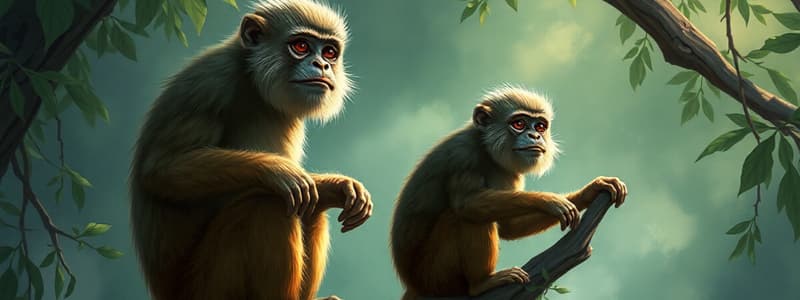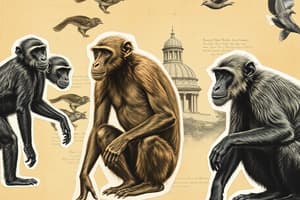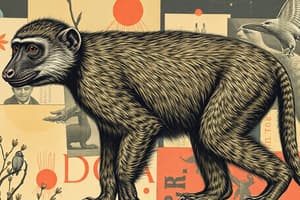Podcast
Questions and Answers
Which characteristic is a shared trait in mammals?
Which characteristic is a shared trait in mammals?
- Laying eggs
- Cold-bloodedness
- Having scales
- Producing mother's milk (correct)
Which of the following is a shared trait in mammals?
Which of the following is a shared trait in mammals?
- Long period of dependence (correct)
- Giving birth to a large number of offspring
- Hibernation during winter
- Short period of dependence
What is a characteristic shared by primates?
What is a characteristic shared by primates?
- No hands or feet
- Only terrestrial lifestyle
- Limited mobility
- Arboreal lifestyle (correct)
What type of hands and feet are typical of primates?
What type of hands and feet are typical of primates?
Which of the following describes the thumb of primates?
Which of the following describes the thumb of primates?
The primate diet is best described as:
The primate diet is best described as:
Forward-facing eyes allow primates to have?
Forward-facing eyes allow primates to have?
What is the general trend in brain size among primates?
What is the general trend in brain size among primates?
The offspring number is generally?
The offspring number is generally?
Newborn primate babies can be described as:
Newborn primate babies can be described as:
What is a characteristic of primate dependency?
What is a characteristic of primate dependency?
What skills are developed in primate play?
What skills are developed in primate play?
Primate communication is considered a?
Primate communication is considered a?
Which of the following is a suborder of primates?
Which of the following is a suborder of primates?
Which primate group includes monkeys, apes, and humans?
Which primate group includes monkeys, apes, and humans?
Which of the following is a characteristic of Strepsirrhini primates?
Which of the following is a characteristic of Strepsirrhini primates?
Which feature can be used to describe the ears of the Strepsirrhini?
Which feature can be used to describe the ears of the Strepsirrhini?
Lemurs, lorises, and galagos all belong to which primate group?
Lemurs, lorises, and galagos all belong to which primate group?
Where do tarsiers fit into primate classification?
Where do tarsiers fit into primate classification?
How many premolars do Platyrrhines have?
How many premolars do Platyrrhines have?
Catarrhines include which group?
Catarrhines include which group?
Which primates have a complex stomach?
Which primates have a complex stomach?
What dental pattern do Catarrhines exhibit?
What dental pattern do Catarrhines exhibit?
Groups of female Catarrhines are called?
Groups of female Catarrhines are called?
Which group do Gibbons belong to?
Which group do Gibbons belong to?
What dental pattern can be used to describe Hominoids?
What dental pattern can be used to describe Hominoids?
What does have a canine diastema mean?
What does have a canine diastema mean?
Which adaptation would be seen with a smaller primate?
Which adaptation would be seen with a smaller primate?
Which of the following traits refers to locomotion in Hominins?
Which of the following traits refers to locomotion in Hominins?
Which of the following describes the feet of the Hominins?
Which of the following describes the feet of the Hominins?
Analogous traits are?
Analogous traits are?
What traits are used to classify mammals:
What traits are used to classify mammals:
Arboreal quadrupeds, like monkeys, use their tail for?
Arboreal quadrupeds, like monkeys, use their tail for?
Primates with forward-facing eyes typically experience an expansion of which area?
Primates with forward-facing eyes typically experience an expansion of which area?
An animal with a vegetarian diet of insects is best known as a:
An animal with a vegetarian diet of insects is best known as a:
What are primates with the ability to perform vertical clinging and leaping known as?
What are primates with the ability to perform vertical clinging and leaping known as?
Primates that eat primarily fruit are known as?
Primates that eat primarily fruit are known as?
What is the advantage of primates with larger bodies?
What is the advantage of primates with larger bodies?
Hominoids are grouped as:
Hominoids are grouped as:
What is a likely characteristic of Hominins?
What is a likely characteristic of Hominins?
Mammals are known for laying eggs.
Mammals are known for laying eggs.
All mammals nurse their young with mother's milk.
All mammals nurse their young with mother's milk.
Mammals typically have a short period of dependence as offspring.
Mammals typically have a short period of dependence as offspring.
Fur or hair is a trait of mammals.
Fur or hair is a trait of mammals.
Primates all have laterally placed scapulas.
Primates all have laterally placed scapulas.
Flexible arm movement is a shared physical trait of primates.
Flexible arm movement is a shared physical trait of primates.
A non-opposable thumb is a shared trait among primates.
A non-opposable thumb is a shared trait among primates.
Having grasping feet is a shared physical trait of primates.
Having grasping feet is a shared physical trait of primates.
All primates have a carnivorous diet.
All primates have a carnivorous diet.
Forward facing eyes are a shared physical trait of primates.
Forward facing eyes are a shared physical trait of primates.
Primates typically have a smaller brain compared to other mammals.
Primates typically have a smaller brain compared to other mammals.
Primates always have poor color vision.
Primates always have poor color vision.
Primates generally give birth to a large number of offspring at once.
Primates generally give birth to a large number of offspring at once.
Primate infants are born independent and require little parental care.
Primate infants are born independent and require little parental care.
Primates reach sexual maturity faster than most other mammals.
Primates reach sexual maturity faster than most other mammals.
Primate communication exclusively involves complex spoken language.
Primate communication exclusively involves complex spoken language.
Primate communication can be symbolic, where meaning is tied directly to a specific referent.
Primate communication can be symbolic, where meaning is tied directly to a specific referent.
Referential communication involves a sound paired with an object.
Referential communication involves a sound paired with an object.
Primate communication is considered an open system.
Primate communication is considered an open system.
Lemurs are an example of the Strepsirrhini primate.
Lemurs are an example of the Strepsirrhini primate.
Mouse lemurs belong to the Haplorrhini primate.
Mouse lemurs belong to the Haplorrhini primate.
Tarsiers are classified under the Tarsiiformes infraorder.
Tarsiers are classified under the Tarsiiformes infraorder.
Howler monkeys are classified as Catarrhini.
Howler monkeys are classified as Catarrhini.
Apes are classified as Hominoidea.
Apes are classified as Hominoidea.
Strepsirrhini primates have shorter snouts relative to Haplorrhini primates
Strepsirrhini primates have shorter snouts relative to Haplorrhini primates
Stereoscopic vision is a primate trait of Strepsirrhini.
Stereoscopic vision is a primate trait of Strepsirrhini.
Quadrupedal locomotion involves vertical clinging and leaping.
Quadrupedal locomotion involves vertical clinging and leaping.
Female primates dominate social groups.
Female primates dominate social groups.
Haplorrhini primates possess a rhinarium.
Haplorrhini primates possess a rhinarium.
Haplorrhini primates have better vision than Strepsirrhini primates.
Haplorrhini primates have better vision than Strepsirrhini primates.
Tarsiers are known to be diurnal.
Tarsiers are known to be diurnal.
Tarsiers are classified as Haplorrhines.
Tarsiers are classified as Haplorrhines.
Platyrrhines includes New World Monkeys.
Platyrrhines includes New World Monkeys.
Platyrrhines have three premolars.
Platyrrhines have three premolars.
All Catarrhines are arboreal.
All Catarrhines are arboreal.
Catarrhines can have complex stomachs.
Catarrhines can have complex stomachs.
Hominoids have short trunks.
Hominoids have short trunks.
Pongids have short limbs.
Pongids have short limbs.
Gorillas are quadrupeds and knuckle-walkers.
Gorillas are quadrupeds and knuckle-walkers.
Bonobos are known to exist in stable, female centered-groups.
Bonobos are known to exist in stable, female centered-groups.
Flashcards
Mammals
Mammals
Chordates with fur or hair and milk glands.
Primates
Primates
Mammals with collar bones and grasping fingers.
Unique Primate Traits
Unique Primate Traits
A combination of physical characteristics that is unique to primates
Arboreal Adaptation
Arboreal Adaptation
Signup and view all the flashcards
Prehensile Hands and Feet
Prehensile Hands and Feet
Signup and view all the flashcards
Opposable Thumb
Opposable Thumb
Signup and view all the flashcards
Omnivorous Diet
Omnivorous Diet
Signup and view all the flashcards
Forward-Facing Eyes
Forward-Facing Eyes
Signup and view all the flashcards
Stereoscopic & Color Vision
Stereoscopic & Color Vision
Signup and view all the flashcards
Larger Brain Size
Larger Brain Size
Signup and view all the flashcards
Strepsirrhini
Strepsirrhini
Signup and view all the flashcards
Rhinarium
Rhinarium
Signup and view all the flashcards
Grasping Hands
Grasping Hands
Signup and view all the flashcards
Stereoscopic Vision
Stereoscopic Vision
Signup and view all the flashcards
Female-Dominated Group
Female-Dominated Group
Signup and view all the flashcards
Not Sexually Dimorphic
Not Sexually Dimorphic
Signup and view all the flashcards
Vegetarian Diet
Vegetarian Diet
Signup and view all the flashcards
Quadrupeds
Quadrupeds
Signup and view all the flashcards
Vertical Clinging and Leaping
Vertical Clinging and Leaping
Signup and view all the flashcards
Haplorrhini
Haplorrhini
Signup and view all the flashcards
Fully Formed Placenta
Fully Formed Placenta
Signup and view all the flashcards
Highly Dexterous Hands
Highly Dexterous Hands
Signup and view all the flashcards
Tarsiers
Tarsiers
Signup and view all the flashcards
No Tapetum Lucidum
No Tapetum Lucidum
Signup and view all the flashcards
Vertical Clinger-Leapers
Vertical Clinger-Leapers
Signup and view all the flashcards
Platyrrhines
Platyrrhines
Signup and view all the flashcards
Prehensile Tail
Prehensile Tail
Signup and view all the flashcards
Catarrhines
Catarrhines
Signup and view all the flashcards
Baboons
Baboons
Signup and view all the flashcards
Hominoidea
Hominoidea
Signup and view all the flashcards
Hominoids
Hominoids
Signup and view all the flashcards
Hominoid Dentition
Hominoid Dentition
Signup and view all the flashcards
Canine Diastema
Canine Diastema
Signup and view all the flashcards
Hylobates
Hylobates
Signup and view all the flashcards
Brachiators
Brachiators
Signup and view all the flashcards
Frugivores
Frugivores
Signup and view all the flashcards
Gorillas
Gorillas
Signup and view all the flashcards
Homologous Traits
Homologous Traits
Signup and view all the flashcards
Analogous Traits
Analogous Traits
Signup and view all the flashcards
Clade approach
Clade approach
Signup and view all the flashcards
Flexible Arm Movement
Flexible Arm Movement
Signup and view all the flashcards
Offspring Number
Offspring Number
Signup and view all the flashcards
Long Dependency
Long Dependency
Signup and view all the flashcards
Mother-Infant Bond
Mother-Infant Bond
Signup and view all the flashcards
Imitation
Imitation
Signup and view all the flashcards
Independent Learning
Independent Learning
Signup and view all the flashcards
Deliberate Teaching
Deliberate Teaching
Signup and view all the flashcards
Referential Communication
Referential Communication
Signup and view all the flashcards
Symbolic Communication
Symbolic Communication
Signup and view all the flashcards
Closed System
Closed System
Signup and view all the flashcards
Small Body Size Adaptation
Small Body Size Adaptation
Signup and view all the flashcards
Large Body Size Adaptation
Large Body Size Adaptation
Signup and view all the flashcards
Bipedal
Bipedal
Signup and view all the flashcards
Dish-Shaped Pelvis
Dish-Shaped Pelvis
Signup and view all the flashcards
Straight Lower Limbs
Straight Lower Limbs
Signup and view all the flashcards
Non-Prehensile Feet
Non-Prehensile Feet
Signup and view all the flashcards
Dexterous Hands
Dexterous Hands
Signup and view all the flashcards
Reduced Dentition
Reduced Dentition
Signup and view all the flashcards
Learning Through Culture
Learning Through Culture
Signup and view all the flashcards
Ethnographic Analogy
Ethnographic Analogy
Signup and view all the flashcards
Study Notes
- Focus of Lectures 14 & L15, held on February 10th and 12th of 2025, is on the living primates.
Shared Traits in Mammals
- Mammals share traits such as giving live birth, producing mother's milk, having a long period of dependence, and learning through play.
- Mammals are chordates with fur or hair and milk glands.
Primate Physical Traits
- Primates possess a unique combination of physical traits.
- Arboreal adaptations: designed for tree living.
- Prehensile hands and feet and an opposable thumb.
- Flexible arm movement: allows for better motion in trees.
- Specific upper and lower limb bones for climbing and grasping.
- Omnivorous diet with specialized teeth
- Forward-facing eyes for stereoscopic and color vision
- Primates have a larger brain size compared to other mammals.
Primate Reproduction
- Primates typically have one to few offspring at a time.
- Primate infants are born helpless and require extensive care.
- Primates take a relatively long time to reach sexual maturity.
- These reproductive traits reflect a trade-off between quantity and quality of offspring.
Dependency and Play
- Primates exhibit a long period of dependency on their parents.
- Mother-infant bond is crucial for primate development.
- Physical and social skills are developed through play.
- Learning, imitation, independent learning, and deliberate teaching are key aspects of primate development.
- Length of dependency years varies among species of primates.
Social Communication
- Primates use referential communication: sounds associated with objects or events.
- Primates also engage in symbolic communication, where meaning is arbitrary and without a direct referent.
- Primate communication is typically a closed system.
Primate Classification
- Clade approach- derived vs. ancestral traits.
Strepsirrhini Traits
- These primates are mammal-like with longer snouts, a rhinarium, and a strong sense of smell (olfactory).
- They have mobile ears and primate traits such as grasping hands and stereoscopic vision.
Strepsirrhini Characteristics
- Strepsirrhines include lemurs, lorises, and galagos.
- Females frequently dominate social groups.
- They are generally not sexually dimorphic.
- Diet: vegetarian or insectivorous
- Mode of locomotion: quadrupedal, vertical clinging, and leaping
Haplorrhini Characteristics
- Includes humans, apes, and monkeys.
- They have a rounded braincase.
- These possess better vision and lack a rhinarium (dry nose).
- They have reduced and non-mobile ears.
- Relatively small and flat faces
- More fully formed placenta and highly dexterous hands.
Tarsiers Characteristics
- Nocturnal and arboreal creatures
- Diet: insectivores
- Tarsiers are haplorrhines.
- They have eyes in bony orbits and lack a tapetum lucidum (no eye shine at night).
- These primates are vertical clinger leapers like lemurs.
Platyrrhines
- New World Monkeys
- Three premolars
- Prehensile tails
- Arboreal lifestyle
- Dentition is 2.1.3.3/2.1.3.3.
- Examples: Marmosets, tamarins, and Cebids (e.g. capuchin)
Catarrhines and Cercopithecoids
- The Arboreal Colobine Monkeys; Complex stomach
- Arboreal Monkeys & The Terrestrial Baboons share: 2.1.2.3/2.1.2.3 Dentition, variable sizes, male dominance, and a few offspring.
- Terrestrial Baboons, are sexually dimorphic and exist in female troops.
Hominoids
- Apes and Humans share the categories: Hylobates, Pongids, Hominins
- Hominoids have larger brains, greater flexibility, and longer limbs.
- A short, broad trunk and lack of tail are also characteristics.
Hominoid Dentition
- Flat and rounded teeth and Y-5 pattern
- Canine diastema
Hominoids: Hylobates
- Hylobates locomotion: Brachiators
- Small body size and weight
- Frugivores diet
- Live in small family units
- Little sexual dimorphism
Pongids: Orangutans
- Arboreal
- Frugivores Diet
- Sexually dimorphic
- Socially solitary
- The orangutan diet and predation habits are of interest.
Pongids: Gorillas
- Locomotion: Quadrupedal and knuckle-walkers
- Eat and sleep in trees
- Dominant male-protector in groups
- Flexible group membership
Pongids: Bonobos and Chimpanzees
- Bonobos & Chimpanzees Quadrupedal and bipedal
- Diet: Frugivore, with some meat
- Highly social animals; live in large groups
- Chimpanzees Groups: Stable; female centered groups
- Bonobo Groups: Fluid groups
Primate Adaptations
- Small body size adaptations include being nocturnal, arboreal, and frugivorous.
- Fast movement in trees, high energy needs from fruit sugars, and easier mobility in the night
- Large body size adaptations are being diurnal, terrestrial, and vegetarian.
- Slow-moving terrestrial lifestyle, poor CHO vegetation leading to large guts, being active during the day; protection in large groups
- Increase in brain size relative to body size.
- Larger brains in response to frugivorous diets and the need to remember where and when fruit is produced.
- Safety in numbers- group size is variable: smaller number of primates when feeding at night and a larger number when feeding in the day.
Hominins: Homo sapiens
- Bipedal
- Dish-shaped pelvis
- Straight lower limbs
- Feet are not prehensile, used for solely walking
- Hands are dexterous
- Incisors, canines, and no large teeth or claws
- They have a large complex brain comprised of a cerebral cortex that is responsible for thinking and spoken language.
- Lowered larynx
- Reflect omnivorous diet
- Incisors and canines share similarity and have no spaces between them
Hominins Exhibit Culture
- Learn through culture, using tools like greater apes
- Chimpanzees - termite sticks
- Planning and tool usage; Cracking seeds open with two rocks
Models of Hominin Behavior
- Homologous vs Analogous traits; Traits: common ancestor or independently derived in two primates
- Living primate behavior used as a model
- **Limitations: Ethnographic Analogy a Non-Western traditional societies
- All cultural groups have their own qualities and are not always reflective of a universal pattern.
Studying That Suits You
Use AI to generate personalized quizzes and flashcards to suit your learning preferences.




